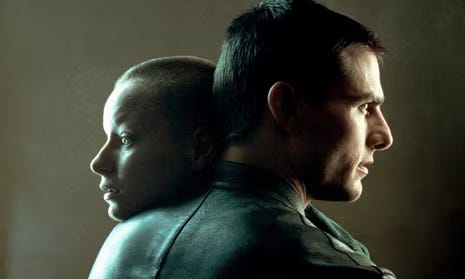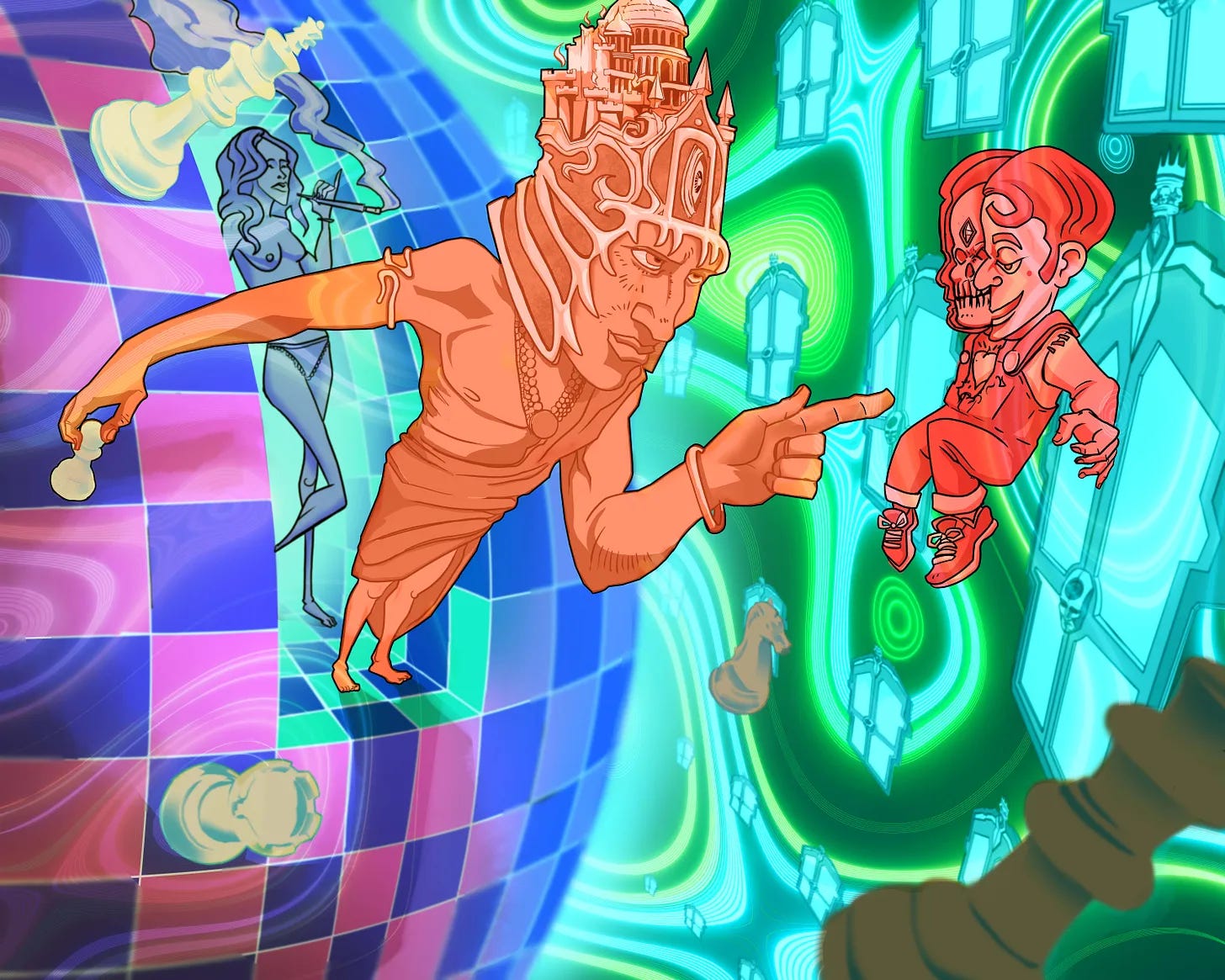Minority Report Part 9: The conclusion
The final part of my Minority Report analysis, a recap and news on my comic
While its been awhile since I have posted my last part to The Minority Report Analysis, however I felt this would be the time to do so. What follows below is my analysis of the ending of Minority Report as well as comparisons with the original and my thoughts on the story implications.
The ending of Minority Report falls for the same problem that Blade Runner’s adaptation did which is that it takes the ideas as far as it thinks the crowd can handle, and then abruptly pulls the parachute and gives us a nice Hollywood style ending. This to me is the problem with adapting Philip’s work into films, often they change aspects of the story that make it feel like a water downed version of Philip’s original idea.
While in the Minority Report film, Anderton kills Leo Crowe and is then put away into the same panopticon precrime prison where he is restrained physically and forced to watch his precrime vision continuously until his wife breaks him out, the written story takes a different turn.
I won’t get into the details of all the differences between the written story and the film, as the details would just make this whole article more convoluted than necessary but I want to draw your attention to why I think the film doesn’t stick the landing compared to the story. If your interested in reading the full story you can here.
The Wiki actually does a great job of summing up this last part so I will share it here:
Anderton is arrested and both he and Lisa, as his accomplice, are scheduled for penal transportation to another planet. Before they leave Earth, Anderton explains to Witwer his reasoning for shooting Kaplan. After obtaining the three precog reports, he discovered that each of them predicted a different outcome. He further realized that the reports had not been generated simultaneously, and that each had been affected by his knowledge of all preceding ones. The first indicated that he would kill Kaplan in order to prevent Precrime from being discredited and shut down; the second predicted that, after reading the first, he would decide to not kill Kaplan. According to the third report, Kaplan had planned to discredit Precrime in order to enact a state of emergency and martial law, resulting in a military coup in which the Army would replace Precrime. Wanting to preserve the status quo, Anderton decided to fulfill the prediction and assassinate Kaplan rather than letting his own innocence destroy the system he helped create…..
…..The existence of three apparent minority reports suggests the possibility of three future time paths, all existing simultaneously, any of which an individual could choose to follow or be sent along following an enticement (as in Anderton's being told he was going to murder an unknown man). In this way, the time-paths overlap, and the future of one is able to affect the past of another. It is in this way that the story weaves a complicated web of crossing time paths and makes a linear journey for Anderton harder to identify. This idea of multiple futures lets the precogs of Precrime be of benefit—because if only one time-path existed, the predictions of the precogs would be worthless since the future would be unalterable. Precrime is based on the notion that once one unpleasant future pathway is identified, an alternative, better one can be created with the arrest of the potential perpetrator.
-Wikipedia, The Minority Report
Preview of my The Golden Man comic adaption from Philip K Dick.
If you are new to this blog you may not be aware but I am currently adapting some of Philip’s short stories into comics, the first one being The Hanging Stranger and the second one which is still in production is The Golden Man. To me I originally picked The Golden Man, seemingly at random from my perspective but as I worked on the comic and wrote this Minority Report analysis, it became apparent to me that they are both connected thematically in a way that I didn’t expect.
The Golden Man is essentially a X men story before X-men, and I imagine it definitely had a influence on Stan Lee. Cris, is a young man who after the fallout of WW3 has a body made of gold and a strange ability to be able to perceive multiple moments of time and space all existing at the same time and pick and choose which one he participates in. Cris gets captured by the DCA (a fictional stand in for the FBI/CIA) and is arrested but because of this ability to perceive time and space independently from his participation in this world he escapes and is practically untouchable:
"He can look ahead. See what's coming. He can — pre-think. Let's call it that. He can see into the future. Probably he doesn't perceive it as the future."
"No," Anita said thoughtfully. "It would seem like the present. He has a broader present. But his present lies ahead, not back. Our present is related to the past. Only the past is certain, to us. To him, the future is certain. And he probably doesn't remember the past, any more than any animal remembers what happened."
-The Golden Man, Wikisource
The Variant Spaces, art print by me. Available for purchase here.
He can pre-think? So essentially he is a precog, and as its mentioned in the synopsis that Wikipedia provides on timelines this ability that the precog has to see into the future is just their vision, but if someone has information about that vision and changes their mind. They will see another updated vision of what could happen.
I think the best way to explain this concept is from another book that I was simultaneously reading called Transurfing Reality, by Vadim Zeland. One of the key concepts that I quote from the book below that struck me as so similar to what Philip talks about in his work is the concept of “The Space of Variations”:
”It is an information structure — infinite data field containing all versions of all events that could happen. You could say that it contains everything that was, is and will be. Space of variations is a template, grid of motion of matter in space and time. Both past and future are there stationary, like frames from a movie roll-film and the time happens only during the movement of an individual frame, in which the present is contained.
Dreams are not illusions in the usual sense. The mind does not invent them — it actually experiences them. Everything we see in reality, is realized variations. And while sleeping, we can see what was not realized, i.e. plays with virtual scenarios and scenery. Dreams show what could happen in the past or can happen in future. Dreaming is a journey of the soul in the space of variations.”
So from Vadim’s perspective what the precogs are doing is peering into this variant space and if enough of them see the same vision this collapses the timeline of that future into our reality. However reality is ever changing and dynamic, so if one is aware of this prediction that alone changes the outcome and thus the vision the precog has.
So precrime at least in the film has a fatal flaw in its assumption about how reality works, that being that there is only one future that is set in stone. This is the reason why I think the film falls flat, we do not from the films perspective learn about this flaw in our understanding of reality that Philip is trying to demonstrate for us. Instead we are walked towards the edge of this understanding but never take flight and instead this whole side of the story is avoided and the movie is wrapped up with a nice bow at the end.
Afterword
I appreciate everyone who has taken the time to read my articles on Minority Report and Blade Runner, I know it took me awhile to get everything out but I appreciate the patience. The Philip K Dick Files is now live with all of the video essays and article links there provided for convenience. I’ll also be putting together a glossary of all my articles and what not and release it on here to make it more convenient for new readers.
For a update on the comic series, The Philip K Dick Files, I am currently about to be kickstarting a physical copy of the first book and then I will be moving on to the next story. As I do so I will continue to write articles on PKD and his work as another part to The Philip K Dick Files. Thanks for reading and stay tuned here for more information on the upcoming Kickstarter for all 3 issues of the comic.
Also if The book Reality Transurfing sounds interesting to you then you can check out the audiobook online, I plan on covering this in the future articles I do as the ideas here overlap with a lot of what PKD talked about. The audiobook is available on YouTube embedded below:





